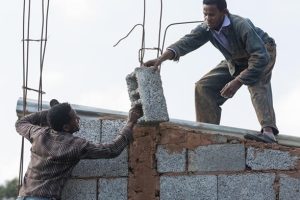
Zinash Girma, 34, arrived at the Dire Health Station, in Bishoftu Town, Oromia State early in the morning for the reason her daughter was not in good health. As soon as she learned that her daughter had a fever in her head, she did not waste a second from going to the nearby health station.
Thanks to the Community Health Insurance Scheme (CBHI), she can access the healthcare service for her daughter by simply showing her Health Insurance ID Card. “I was not asked to pay a penny. We pay 410 birr per year to renew the ID given to us, and anytime we get all the necessary medical services we require, including medicines,” she said.
Recalling that she gave birth to her child in this same health facility, and witnessing that the health station has been providing quality service for the community she said that before the CBHI scheme became operational, the public at large was compelled to spend from 400 to 500 birr; and even more depending on the disease and type of treatments they received.
“Previously, we did not have an idea about CBHI and its benefits. However, following the efforts exerted by health professionals to raise our level of awareness about it, we are fully benefiting from the scheme. These days, almost all members of the community are members of the CBHI scheme. And if any member of the community feels unwell or needs any support, can visit the health station no matter when.” Zinash also gave her advice for those who are not yet incorporated in the CBHI scheme. “Be a member of CBHI and secure unnecessary expenses to get medical services.”
Megertu Mekonnen, 23, was also another patient who came to the Dire Health Station to get medical service for having both a headache and a fever. In previous days, she had been in the same health facility due to tonsillitis. Because she was not a member of the scheme, she was compelled to pay for the required expenses from her pocket. Megertu has no awareness of the CBHI scheme. “Had I known the benefits it has, I would not have waited until now to be a member,” she regretted.
Aklilu Hileye is Head of the Dire Health Station. According to him, the health insurance scheme in the area was started in 2014–15. By then, only some 250 households were willing to accept the scheme. However, the awareness-raising trainings that were given at the woreda and health station levels played a crucial role in attracting the community to the CBHI scheme. Moreover, the involvements of people who have had attachments with health professionals into the scheme have also made others follow the suit. This way, the health insurance scheme was scaled up in the village.
Indicating that more than 28,000 households are residing in the area, Aklilu added: “We have 37,975 members who are benefitting out of the insurance scheme. There is also a motto among the people dubbed as ‘One hen for health insurance,’ to express that a family can get healthcare services with a cost equivalent to selling price of a hen for a year. This motto motivates the community to engage in the CBHI scheme.
Previously, the annual number of people who used to get medical service at the health station did not exceed 5,000. This time, more than 5,000 people have been getting medical services within a month. In relation to the CBHI scheme, enormous numbers of people are now clear about the relevance of health care services. As they are members of health insurance, people residing in the area are confident enough to visit health facilities and get medical assistance when they fall ill, he added.
As to him, due to this health care financing system, the income of the health station is now increasing day in and day out. For instance, in 2015, the income earned was 425,381 Birr. During the last Ethiopian budget year, it collected 1,239,458 Birr. “Following the increment in income, we have been upgrading various services. Laundry machines, screen televisions, and the placenta PCT Center, which were not available before, are now on their way. We are also preparing to import an Ultrasound and CBC test machines to the health station. By and large, the service is now upgraded.”
Abdul Redi is Coordinator of the Ada’a District Health Insurance Office in Bishoftu Town. He said, “We started the insurance scheme with 4,731 members. Of which, 2458 were members who paid and renewed their Identification cards, and 2273 were people who could not afford to pay the annual payment. Now we have 16,695 members; and there are three zones and four cities that are beneficiaries of the health insurance scheme. There are 65 community health insurance institutions led by four experts.”
Mentioning that they made an agreement with seven health stations to provide quality medical service to their members, Abdul said that if the health condition of a patient demands high level services, members will be referred to higher-level hospitals to get the medical treatment they deserve. Equally, if members are not able to get medicine, as per the agreement it was made with the Ethiopian Red Cross Society, they can get it without spending a penny.
In 2015, 354 million Birr were collected from members who could pay the required amount of annual payment. The Woreda Administration also subsidized 26.5 million Birr to members of the community who cannot afford to pay for health insurance services. By and large, over 420 million Birr were collected. Accordingly, as the number of people engaged in the health insurance scheme increases, the quality of health services provided to them also increases. The money collected from members is spent for health facilities, which help them purchase medicine and pay other expenses.
The membership fee was 180 birr when the community health insurance service first started. Then, in 2010, it was 245 birr. The annual fee is now 410 birr, of which 10 Birr covers the cost of the card. Residents who cannot pay will have 30 percent of their costs covered by the district and 70 percent by the regional government. The government allocates 300,000 birr to each health center every year. Healthcare financing is expanding its reach, and many are benefiting. All the registered members of the district have renewed their cards.
Birtukan Abere, Head of the Ada’a District Health Office. At the start-up point, the number of users who started getting the service was small. However, it is now getting increased as the community has learnt about the benefits. For instance, in 2010, 50 percent of the people were members of the scheme; and in 2014, 85 percent of the residents of the district were able to benefit from the health insurance scheme. In 2015, almost all members of the community benefitted from the CBHI scheme.
According to Birtukan, previously, persuading users was not an easy task; and even complaints were made when the government was trying to collect the annual membership fee. Now, things are going smoothly. This community-based health insurance service has lessened the health burden of the people, especially for rural communities. Previously, in order to get healthcare services, they were forced to sell their cattle and farmland. However, the scheme not only reduces the cost of medical treatment, but also enables members to go and get treatment from primary care to tertiary care centers, she added.
“In order to avoid problems related to the use of medical services, we will conduct an audit every three months and follow up with health officers and accountants. In so doing, it was possible to solve the challenges regarding the provision of health services,” she remarked. Ethiopia launched a Community-Based Health Insurance (CBHI) scheme in 2011 with a vision of achieving universal health coverage for its people by reaching 80 percent of districts and 80 percent of its population by 2020.
BY GIRMACHEW GASHAW
THE ETHIOPIAN HERALD FRIDAY 21 JULY 2023





